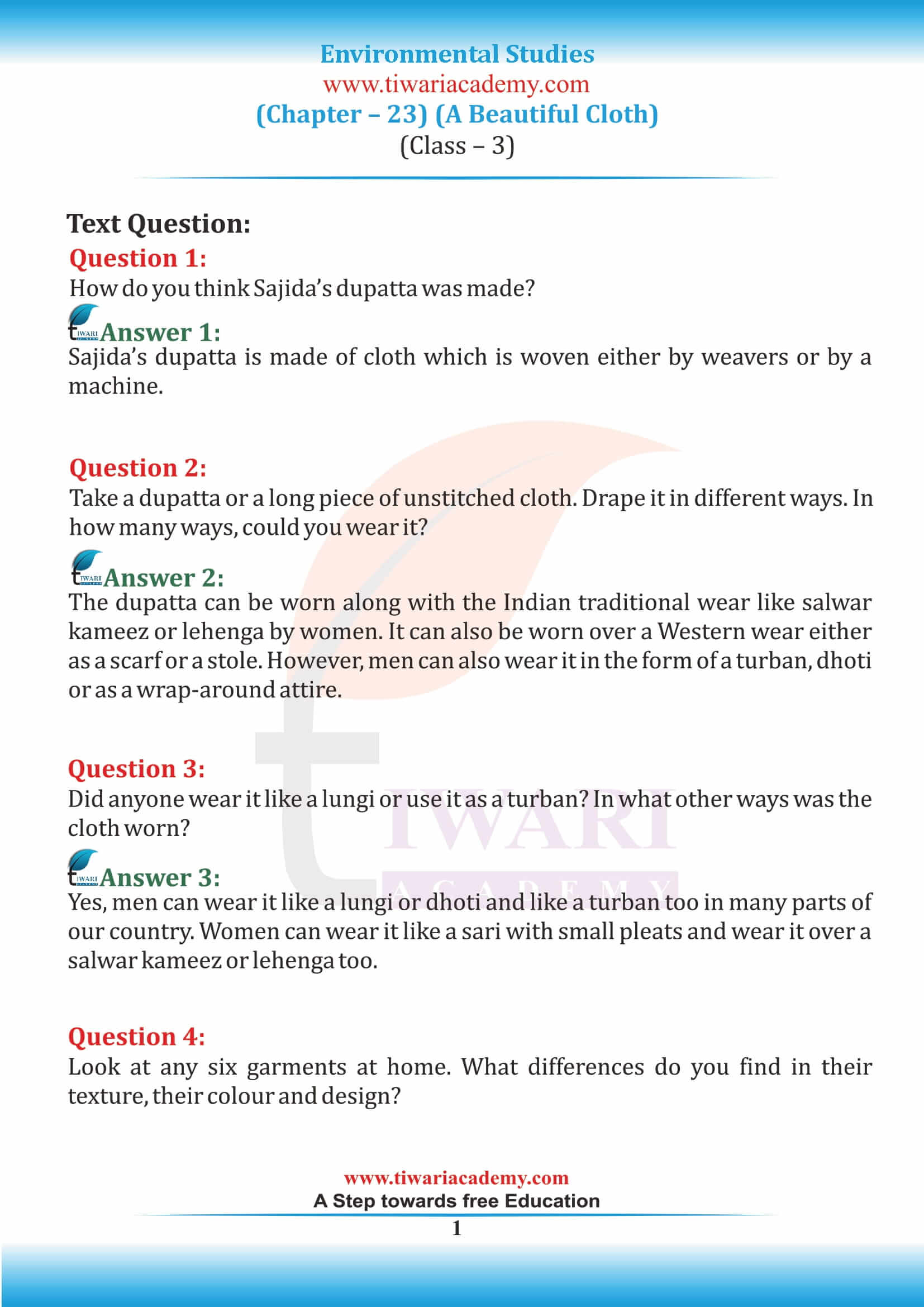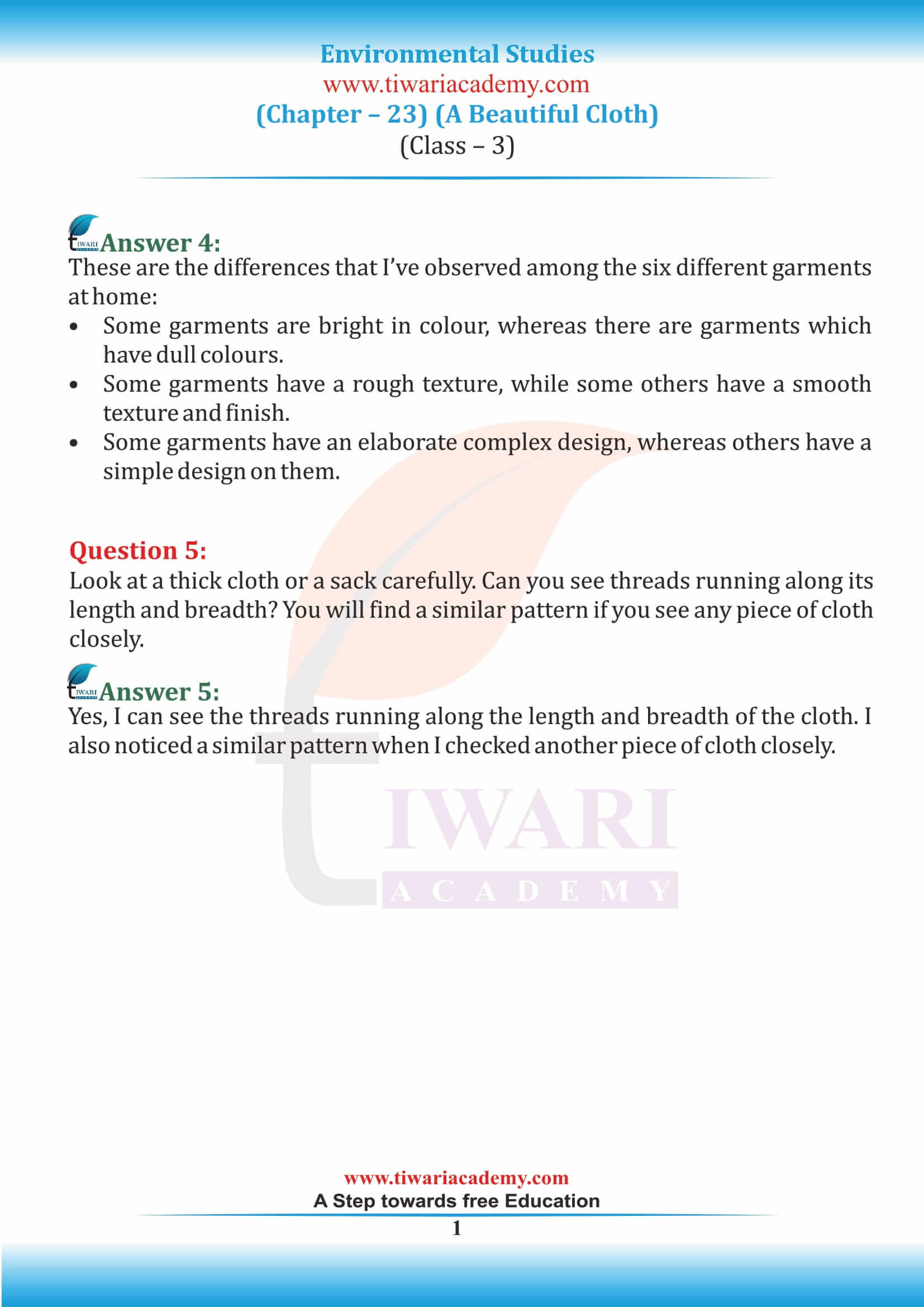NCERT Solutions for Class 3 EVS Chapter 23 A Beautiful Cloth in Hindi and English Medium format free to use online or download in PDF to use it offline. Class 3 EVS Solution are now available in updated format according to CBSE Syllabus 2025-26. Extra questions answers which are important for class test and terminal exams, are also given with suitable answers.
NCERT Solutions for Class 3 EVS Chapter 23
NCERT Solutions for Class 3 EVS Chapter 23 A Beautiful Cloth
How do you think Sajida’s dupatta was made?
Sajida’s dupatta is made of cloth which is woven either by weavers or by a machine.
Take a dupatta or a long piece of unstitched cloth. Drape it in different ways. In how many ways, could you wear it?
Ans. The dupatta can be worn along with the Indian traditional wear like salwar kameez or lehenga by women. It can also be worn over a Western wear either as a scarf or a stole. However, men can also wear it in the form of a turban, dhoti or as a wrap-around attire.
Did anyone wear it like a lungi or use it as a turban? In what other ways was the cloth worn?
Yes, men can wear it like a lungi or dhoti and like a turban too in many parts of our country. Women can wear it like a sari with small pleats and wear it over a salwar kameez or lehenga too.
Look at any six garments at home. What differences do you find in their texture, their colour and design?
These are the differences that I’ve observed among the six different garments at home:
• Some garments are bright in colour, whereas there are garments which have dull colours.
• Some garments have a rough texture, while some others have a smooth texture and finish.
• Some garments have an elaborate complex design, whereas others have a simple design on them.
Look at a thick cloth or a sack carefully. Can you see threads running along its length and breadth? You will find a similar pattern if you see any piece of cloth closely.
Yes, I can see the threads running along the length and breadth of the cloth. I also noticed a similar pattern when I checked another piece of cloth closely.
Class 3 EVS Chapter 23 Extra Questions Set 1
_______ is a very long piece cloth worn by Indian woman.
Fabric is a cloth made up of different types of:
Cotton fibre is obtained from _________ plants.
We get wool from the fleece of the _________.
Fibres are made into ______ by spinning.
Class 3 EVS Chapter 23 Extra Questions Set 2
__________ and ________ are plants fibre.
Thread work done on a cloth is called _________.
In olden days, people used to spin on __________.
The yarn is woven into cloth in:
The clothes worn by early humans were made up of:
Give reasons why we wear clothes as per the climate of the place?
The clothes we wear have to be suitable for the work we do as well as per the local climate. In hot places or in summer season, people wear light coloured loose cotton clothes. This helps them in keeping cool and absorb all the sweat. At cold places or in winter season, people usually wear dark-coloured layers of woollen clothes. The warm air trapped between these layers keeps the cold out and we feel warm. Different types of fabrics are suitable for different seasons. We wear clothes according to the climate.
Write a short note on wool.
i. Wool is obtained from the fleece or hair of the sheep. goat, camel. Yak. Rabbit and other animals.
ii. These animals have a thick coat of hair on their bodies because the hair traps air and air is a poor conductor of heat. So, the thick layer of hair keeps the body and warms and protects them from harsh cold.
iii. For obtaining wool, animals are reared and then their hair is cut and processed into wool
What are the qualities of cotton?
Man learnt to make cotton fibre from the cotton bolls that grow on cotton plant.
• Cotton fibre is used to make cotton clothes.
• Cotton clothes are light and cool.
• Cotton is a breathable fabric which allows the air to move through it.
• Cotton clothes are best for summer season or at hot places.
• Cotton is used to make frocks, shirts, skirts, kurta-pyjamas, sarees, tops, etc.
Write a short note on silk
Silk was first discovered in China. Man learnt to use the cocoon of silkworm to yield silk fibre which is woven into beautiful silk fabric. Silk is a shiny and expensive cloth. People wear silk clothes on special occasions. · Silk is used in making sarees, salwar suits, brocade, dupattas etc.
Class 3 EVS Chapter 23 Important Question and Answers
How is silk made?
Silk is a natural fiber produced by the silkworm. Silkworms are the offspring of moths. They emit out thread from tiny holes in their jaws, which they use to spin into their egg-bearing cocoons. This entire production takes a mere 72 hours, during which time they produce between 500-1200 silken threads.
Why is washing of clothes important?
Clothes need to be taken care of to ensure their long life and rich look. So, we need to wash them properly and take proper care of them
• We must wash our clothes regularly in clean water, using soap or detergent powder.
• We must take care that all the soap or detergent is washed away completely; otherwise the clothes may become discoloured and cause skin infections too.
• White clothes need to be soaked in indigo powder (neel) and dried in the sun. They may also need to be bleached sometimes.
What is the oldest method of making a textile?
Weaving is the oldest method of making yarn into fabric. The process of intertwining threads together is called weaving. Long threads are woven together to make cloth. A device called ‘loom’ helps in weaving the clothes.
What does printing on cloth mean?
Textile printing is the process of applying colour to fabric in definite patterns or designs. In printing, wooden blocks, stencils, engraved plates, rollers, or silk screens can be used to place colours on the fabric. It is a process of decorating textile fabrics by application of pigments, dyes, or other related materials in the form of patterns.
Why do we need clothes?
We all need clothes to cover our body and to protect ourselves from different weather conditions. We wear clothes to protect our body from heat, cold, dust, rain and germs. They make us look good and presentable.
How many types of fibres are there?
There are two types of fibres – Natural and Man-made
• Natural fibres – The fibres that we get from plants or animals are called Natural Fibres. E.g. wool, silk, jute and cotton etc
• Man -made fibres – The fibres that are made by man by using chemicals are called Man- made fibres. E.g. nylon, rayon, polyester etc.
List a few qualities of man- made or synthetic fibres.
1. Fibres like nylon and rayon are shiny with rich look and feel.
2. They are used to make soft and comfortable fabrics.
3. Clothes made by these fibres are durable and long lasting.
What are the traditional embroideries of the following states?
i. Bengal-Kantha work
ii. Punjab – Phulkari embroidery.
iii. Lucknow – Chikankari embroidery.
iv. Andhra Pradesh – Kalamkari.
v. Rajasthan – Bandhini
After reading Sajida’s story in Chapter 23 of class 3rd EVS what did you find out about the skill showcased there?
After reading Sajida’s story I found out the textiles work and handicraft work are some of the skills that have been showcased in the story which tells us how some of the skills should be protected because all those designs are handmade.
Why do you think students of class 3 EVS should read and understand chapter 23rd?
The knowledge given in chapter 23 about designing skills is important for students to develop creativity. Meanwhile, this is how they will be able to value the handmade designs and that could save the traditional skills too.
What activity do you suggest for class 3rd chapter 23rd of EVS to the students to improve their understanding?
There are a few of the activities that we can suggest that are taken from class 3 chapter 23 of the EVS book.
There are certain designs that are given in the story that seems like printed with the help of “Okhra” vegetable and that is How one can use different veggies to create some outstanding designs one some solid fabrics with colors.





